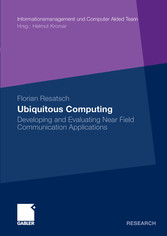Search and Find
Service
More of the content

Ubiquitous Computing - Developing and Evaluating Near Field Communication Applications
Foreword
6
Acknowledgements
7
Abstract
9
Contents
11
List of Figures
17
List of Tables
20
Abbreviations
22
1 Introduction
25
1.1 Field of Investigation
26
1.2 Research Problem
28
1.3 Research Questions and Objectives
31
1.4 Methodology
32
1.5 Thesis Structure
36
2 Theoretical Framework
39
2.1 Ubiquitous Computing
39
2.1.1 Definition
39
2.1.2 Building Blocks
41
2.1.3 Technologies
42
2.1.4 Radio Frequency Identification (RFID)
44
2.1.4.1 Standards
44
2.1.4.2 RFID Tag and Data
45
2.1.4.3 Capacity
46
2.1.4.4 Shapes and Form
46
2.1.4.5 Frequencies
47
2.1.4.6 Transmission
48
2.1.4.7 Readers and Connectivity
49
2.1.4.8 Cost
50
2.1.5 Near Field Communication (NFC)
51
2.1.5.1 NFC Forum Technology Architecture
51
2.1.5.2 Mobile NFC Architecture
53
2.1.5.3 Available NFC Phones
54
2.1.5.4 Developing with NFC
56
2.1.5.5 NFC Tags
57
2.1.6 RFID and NFC Information Systems
58
2.2 Ubiquitous Computing Technologies and the Consumer
59
2.2.1 Categorization of Applications Using the Example of RFID
59
2.2.2 User Awareness and Perception of RFID
61
2.3 The Importance of Prototyping
68
3 Human Computer Interaction and Technology Acceptance
70
3.1 Human Computer Interaction
70
3.1.1 Human Aspects
71
3.1.1.1 The End-User
71
3.1.1.2 Behavioral Constraints of the End-User
72
3.1.1.3 Everyday Tasks
73
3.1.1.4 Cognitive Limitations
74
3.1.1.5 Context-Sensitive Applications to Limit the Cognitive Load
76
3.1.2 Human Computer Interface
77
3.1.2.1 Multimodal Interaction
78
3.1.2.2 Haptic Interfaces
79
3.1.2.3 Affordances
81
3.1.2.4 The Interaction Design of an Everyday Task
81
3.1.2.5 Interaction between Physical Objects and Mobile Devices
82
3.1.3 Summary: Preliminary Set of Requirements
84
3.2 Technology Acceptance
87
3.2.1 Technology Acceptance Evaluation in Ubiquitous Computing
87
3.2.2 Innovation Adoption
88
3.2.3 Technology Acceptance Models
92
3.2.3.1 Social Cognitive Theory (SCT)
93
3.2.3.2 Theory of Reasoned Action / Theory of Planned Behaviour (TRA/TPB)
93
3.2.3.3 Technology Acceptance Model (TAM)
94
3.2.3.4 Task-Technology Fit (TTF)
95
3.2.3.5 Motivational Model (MM)
96
3.2.3.6 Unified Theory of Acceptance and Use of Technology (UTAUT)
96
3.2.3.7 Critical Assessment of Acceptance Models
106
3.2.4 Summary: Technology Acceptance and Implications
107
4 Designing an Ubiquitous Computing Application Development and Evaluation Process Model (UCAN)
109
4.1 Ubiquitous Computing Application Development
109
4.1.1 Determining Initial Requirements
110
4.1.2 Challenges
112
4.1.3 End-User Integration
113
4.1.4 Prototypes
114
4.1.5 System Engineering and Prototyping
116
4.2 Evaluating Ubicomp Applications
117
4.2.1 Challenges
117
4.2.2 Evaluating Prototypes
118
4.2.3 Evaluation in Specific Prototype Phases
120
4.3 A-priori: The Ubiquitous Computing Application Development and Evaluation Process Model (UCAN)
125
4.4 Selection of Case Studies
126
4.4.1 NFC Applications
126
4.4.1.1 Technology Push
127
4.4.1.2 Market Pull
127
4.4.2 Selection Criteria
127
4.4.3 Motivation
129
4.4.4 Conducting the Case Studies
130
4.4.5 Overview
131
5 From Initial Idea to Low-Fidelity Prototype: Easymeeting and the Mobile Prosumer
133
5.1 Easymeeting: Meeting Room Management System
133
5.1.1 Vision of a Motivating Application
134
5.1.2 General Problem: Ubiquitous Computing in a Work Environment
135
5.1.3 Initial Idea
135
5.1.4 Evaluation of the Initial Idea
135
5.1.5 Refined Idea
136
5.1.6 Low-Fidelityy Prototypee
139
5.1.7 Evaluation of the Low-Fidelity Prototype
142
5.1.7.1 Research Methodology
142
5.1.7.2 Sample
143
5.1.7.3 Data Collection and Data Coding
143
5.1.8 Evaluation Results of the Low-Fidelity Prototype
144
5.1.8.1 Evaluation Results—Qualitative with ”Talking out Loud” Method
144
5.1.8.2 Evaluation Results—Quantitative According UTAUT Items
145
5.1.9 Refined Use Case
148
5.1.10 Summary of the Results—Easymeeting
150
5.1.10.1 Improve and Theorize about the Developed Process Model (UCAN)
150
5.1.10.2 Preparing Design Guidelines
152
5.2 Mobile Prosumer: Smart Product Information System at the Point of Sale
154
5.2.1 Vision of a Motivating Application
156
5.2.2 General Problem: Smart Products and Information Services
156
5.2.2.1 Differences in Online and Offline Shopping
157
5.2.2.2 Smart Products—Bridging the Gap of Offline and Online Information
157
5.2.2.3 Demand for RFID-based Information Services at the Point of Sale
159
5.2.3 Initial Idea
160
5.2.4 Evaluation of the Initial Idea
161
5.2.5 Refined Idea
161
5.2.6 Low-Fidelity Prototype
162
5.2.7 Evaluation of the Low-Fidelity Prototype
163
5.2.7.1 Research Methodology
164
5.2.7.2 Sample
165
5.2.7.3 Data Collection and Data Coding
166
5.2.8 General Evaluation Results
166
5.2.8.1 Experiences and Attitude towards Shopping
166
5.2.8.2 Evaluating the Initial Idea—Paper-based Concept Test
167
5.2.9 Low-Fidelity Prototype Evaluation
169
5.2.9.1 Low-Fidelity Prototype Evaluation—Focus Group 1: Consumers
169
5.2.9.2 Low-Fidelity Prototype Evaluation—Focus Group 2: Sales Assistants
169
5.2.10 Refined Use Case
170
5.2.11 Summary of the Results – Mobile Prosumer
173
5.2.11.1 Improve and Theorize about the Developed Process Model (UCAN)
173
5.2.11.2 Preparing Design Guidelines
175
6 Working Prototype: An NFC-based Mobile Phone Ticketing System
177
6.1 From the Initial Idea to the Working Prototype
178
6.2 Working Prototype
181
6.3 Evaluation of the Working Prototype
183
6.3.1 Sample
185
6.3.2 Preparing the Research Design
186
6.3.2.1 Questionnaire Concept
186
6.3.2.2 Adaptation of Original UTAUT Constructs
186
6.3.2.3 Summary of Items and Constructs
195
6.3.2.4 Determining Measurement Points
196
6.3.3 Data Collection
197
6.3.4 Data Processing
198
6.4 Data Analysis and Interpretation
199
6.4.1 Data Analysis
199
6.4.2 PLS Analysis
200
6.4.3 Interpretation
205
6.4.3.1 Behavioural Intention
205
6.4.3.2 Performance Expectancy
208
6.4.3.3 Effort Expectancy
209
6.4.3.4 Social Influence
209
6.4.3.5 Attitude towards Using Technology
210
6.4.3.6 Self Efficacy
210
6.4.3.7 Anxiety
210
6.4.3.8 Facilitating Conditions
210
6.4.4 PLS Multi-Group Comparisons
211
6.4.5 Further Results
211
6.4.6 Direct Limitations
213
6.5 Summary of the Results
215
6.5.1 Improve and Theorize about the Developed Process Model (UCAN)
215
6.5.1.1 Benefits of the Process
215
6.5.1.2 Limitations of the Proces
216
6.5.1.3 Evaluation of the Research Instrument: Quantitative Survey
216
6.5.2 Preparing Design Guidelines
217
7 Conclusion, Limitations, and Future Research
219
7.1 Conclusion
219
7.1.1 Evaluation of the Case Studies
220
7.1.2 Technological Comparison
221
7.1.3 Improving UCAN
223
7.1.4 Design Guidelines for NFC-based Ubiquitous Computing Applications
229
7.1.5 Contributions of the Analysis
236
7.2 Limitations and Future Research
239
7.2.1 Limitations
239
7.2.2 Future Research
240
Bibliography
242
Appendix
259
All prices incl. VAT












